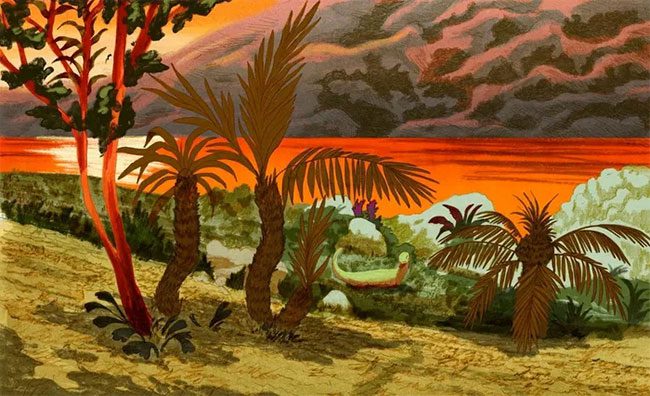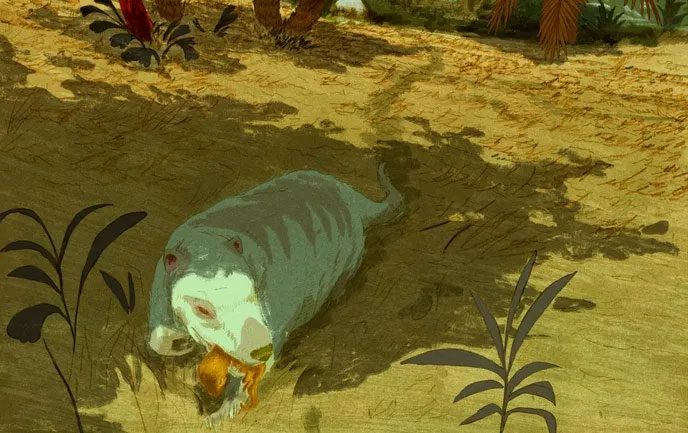Some dinosaurs grew to enormous sizes, like Stegosaurus, or even larger, such as the long-necked dinosaurs. They could defend themselves against carnivorous dinosaurs.
125 million years ago, hidden among dense bushes, a female Psittacosaurus was keeping watch over a large pile of leaves. Its name means “parrot lizard.” This is not because it had long feathers standing upright on its tail, but because, like all dinosaurs of its family, its head resembled that of a modern parrot, complete with a short, large beak! It used that beak to cut through vegetation for food.
This female was nearly 2 meters long, slightly larger than a human. That is a small size for a dinosaur, but quite large compared to the mammals scurrying around in the forests of that time. And if it was keeping watch, it was waiting for a joyful event.
Suddenly, a small sound emerged from the pile of leaves. Then another sound followed. The rustling noises were discreet. Psittacosaurus circled around its nest, a burrow made of dry mud. It had laid about twenty eggs in there, then covered them with leaves. And underneath the nest, something began to stir! It gently used its beak to push the leaves aside. One egg cracked open, and a piece of shell fell away.

Psittacosaurus, or parrot lizard hatching eggs. (Illustration: Kim Đồng Publishing House).
Through this tiny window, the mother noticed an eye looking at her in amazement. Moments later, the shell broke apart under the pressure of tiny legs: the first baby from the clutch was here! It looked just like its mother, but was very small. The mother gently sniffed it as it emerged from the shell. Then another hatchling broke free from the mess of leaves, followed by another one… They were born almost simultaneously, as if the first one had signaled its siblings.
The next day, the hatchlings were already steady on their feet. The mother cleared away the broken eggshells piled in the nest. Her young ones were constantly wriggling, moving from one side of the nest to the other on their four legs. They needed time to learn how to stand on their hind legs.
A few days later, the mother was overwhelmed, with all the little ones chirping and leaving the nest to explore the world with their unsteady steps! She tried to gather them back, calling them with urgent squeaks, not wanting them to wander too far…
She had good reason. Because under the shade of a bush, just a few steps away, two eyes were watching hungrily. It was a Repenomamus, the largest mammal of its time. In fact, it wasn’t very impressive, measuring only 1 meter long. But it was a force of Nature! It resembled a badger, with short legs and a large head, a strong jaw, and a bushy tail. Unlike all the small mammals living at that time, it didn’t leave its burrow at night. It preferred daylight. It was skilled and aggressive enough to discourage carnivorous dinosaurs from taking it on…
It had been waiting for a while. Repenomamus didn’t want to take unnecessary risks; a fierce bite from the mother could crush it. It was patient. And it knew that an opportunity would eventually arise… It set its sights on one of the Psittacosaurus hatchlings that was far from the nest and right in its line of sight, completely unaware of the danger. Repenomamus lunged and bit it, killing it instantly with a single snap, before turning and fleeing immediately. It didn’t run very fast, moving awkwardly, but what could the mother Psittacosaurus do?

Repenomamus lurking to snatch a Psittacosaurus chick from the nest for food. (Illustration: Kim Đồng Publishing House).
She charged towards it with a heart-wrenching cry, but she had to quickly abandon the chase to return to keep an eye on the other hatchlings. It must be said that they were constantly wriggling, crying out, and all that commotion risked attracting other predators, whether mammals or dinosaurs… In any case, it was too late; Repenomamus had swallowed the careless little one whole, without even bothering to tear it apart or chew.
One thing is certain: fortunately, female Psittacosaurus laid many eggs each time. Because mothers could never protect all their offspring at once, and despite their best efforts, most of them did not survive to adulthood. While such dramas unfolded on the ground, bird-like dinosaurs soared and played hide-and-seek among the treetops, with mammals trying to mimic them.





















































